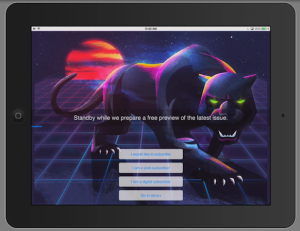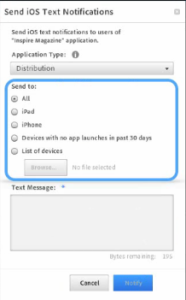Last Friday, Adobe started rolling out Phase 2 of its two-stage release of Digital Publishing Suite v29. (Phase 1 became available on Dec. 6.) In a webinar presented on Jan. 13, Adobe’s Digital Publishing Evangelist, Colin Fleming, described the feature enhancements included in Release 29.
The following features are part of the full rollout of Adobe DPS v29:
Welcome Screen for iOS
This feature was previously released for the iPhone and is now available for the iPad as well. A custom Welcome Screen can be used to greet readers or provide guidance and information to new readers. It appears after the first launch of your app following installation or after an update to your app. It is HTML-based and should be coded for iOS. Transparency is supported, and the Welcome Screen can be a full or partial screen appearing with your library or store. Interactive features can also be included. Welcome Screen code and assets are a single set of content built into the app and added in the DPS App Builder. Your code needs to support the devices your app supports, i.e., it should handle and display on both iPhone and iPad. This is an iOS and Enterprise-only feature.
Targeted Text Notifications
Publishers can now target their readers with specific text notifications based on the type of device they use to access content, using preconfigured device sets: You can target all iOS devices, just iPads, just iPhones, or just devices that haven’t launched your app in the past 30 days. SiteCatalyst customers (iOS devices only) can also target specific readers with text messages based on usage data such as specific device used or on users having read or downloaded a particular article.
Streaming Audio and Video Directly Within Apps
Thanks to new DPS authoring features in InDesign, publishers can reduce file sizes and improve folio download times by including streaming audio and video content directly within an app. Another benefit is that streaming resource content can be changed without updating the folio. Note that there are now separate Audio and Video panes in the Folio Overlays panel. They both contain a new URL field and asset collector; if you paste in the URL for an online resource, it will stream if the asset is available via HTTP. (Note that HTTPS is not supported.) Publishers are advised to design content to work both online and offline, since offline users won’t be able to access the streaming content.
Base Analytics Portal
This feature is now out of beta and includes bug fixes. The analytics UI is HTML-based and is now localized. Publishers can now also use it to track auto-starts versus user-initiated overlays in the iOS viewer.
Pop-up Paywall Eliminated for Free Content
If a publisher is offering a free issue, the paywall will not pop up, and this content will always be available regardless of metering or protection settings. Publishers can still limit fulfillment, as this is independent of the paywall.
Sharing Improvements
Sharing functionality continues to expand for DPS. With this release, if readers share a DPS article URL with a friend, and that friend is entitled to view the content, they will see the full article; otherwise, the user will be brought to the paywall. In addition, if a folio is published as free, all articles within the free folio are available in the web viewer.
Adobe Content Viewer for Windows
Adobe Content Viewer is now available in the Windows Store and works on Windows 8.1 tablets, laptops, and desktops.
Android 4.4 Support
For those creating Android apps, DPS now supports Android 4.4. You’ll need to update your app and resubmit it to incorporate this support. There is also now pinch-and-zoom support for “horizontal swipe only” in Android apps.
Updating to V29 or Not?
If you are on a DPS version older than v28, you will need to update your Folio Builder to v28 or later. Adobe’s DPS team released this announcement:
“Now that DPS v29 Phase 2 is complete, you must update the Folio Builder panel to v28 or later if you’re using InDesign CS5/CS5.5. For InDesign CS6/CC, update the DPS Desktop Tools (v28 or later is required). Installation instructions for the DPS Tools can be found here.”
A more detailed preview of features planned for DPS v30 and v31 is planned for early February, along with news related to Android apps, so stayed tuned!
If you’d like to be notified when the next DPS update is scheduled to occur, join TFP’s Adobe Digital Publishing Suite mailing list.
Posted by: Margot Knorr Mancini




